Hudson Fellowship Day 16
 Wednesday, July 22, 2009 at 11:37PM
Wednesday, July 22, 2009 at 11:37PM 
For posts 2006-2010
please visit
sadievaleri.blogspot.com
Sadie’s current site is at
SadieValeriAtelier.com
UPDATE February 1, 2021
I have recently discovered that unfortunately this Squarespace blog has failed to maintain most the images for older posts on this blog. Luckily, the original Blogger version is still live at sadievaleri.blogspot.com and all the posts and images from 2006-2010 are still visible there.
For my current artwork, teaching, and blog please visit Sadie Valeri Atelier.
 Wednesday, July 22, 2009 at 11:37PM
Wednesday, July 22, 2009 at 11:37PM 
 Tuesday, July 21, 2009 at 2:58PM
Tuesday, July 21, 2009 at 2:58PM 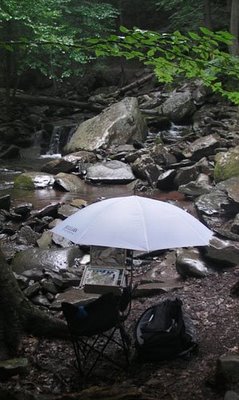
 Above I started with a line drawing to block-in the layout using a small round synthetic brush, and a paper towel corner dipped in turp for an eraser.
Above I started with a line drawing to block-in the layout using a small round synthetic brush, and a paper towel corner dipped in turp for an eraser.


Yesterday evening we went out to do another sunset study. This one again suffers from being too light. Not sure I'm cut out for the lightening-speed approach this requires to capture the hues, values and chroma.
 Monday, July 20, 2009 at 6:07PM
Monday, July 20, 2009 at 6:07PM
Today I went back to Olana today to complete the painting I began last Thursday. Luckily the weather was similar to the previous session. I adjusted the composition and refined the colors and added more detail overall. I also adjusted the shape of the river quite a bit, I think in this version it sits on the plane of the earth more accurately.
 Thursday, July 16, 2009 at 10:45PM
Thursday, July 16, 2009 at 10:45PM 
 Monday, June 29, 2009 at 6:10PM
Monday, June 29, 2009 at 6:10PM  Wednesday, June 17, 2009 at 1:50AM
Wednesday, June 17, 2009 at 1:50AM 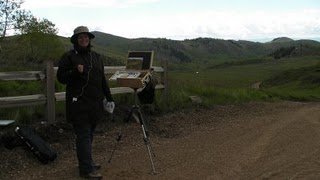

 It was very, very cold. I actually had a single HAILSTONE land in my pochade box. Do I get some sort of plein air badge for that?
It was very, very cold. I actually had a single HAILSTONE land in my pochade box. Do I get some sort of plein air badge for that? My amazing dad knit me these fingerless painting mittens from the softest green wool. From this angle you can't see, but they even have an intricate cable braid down he back of the hand. Far too nice to use for painting, but he insisted it's ok if I get paint on them.
My amazing dad knit me these fingerless painting mittens from the softest green wool. From this angle you can't see, but they even have an intricate cable braid down he back of the hand. Far too nice to use for painting, but he insisted it's ok if I get paint on them. Friday, June 5, 2009 at 4:57PM
Friday, June 5, 2009 at 4:57PM NOTE: This started as a brief addition at the bottom of the previous post, but then I ended up describing more details in an email to someone... then realized it's worth devoting a whole new post to wet sanding.
I did the wetsanding on fairly-dry areas - maybe a week of drying. Dry to the touch, but you could probably still gouge or dent the surface if you tried. I was also willing to repaint whatever I messed up. (I wouldn't try it for the very first time on a masterpiece you thought was done and no longer have reference for, in case a little repainting is necessary.)
Also, it's not sanding like you sand a piece of furniture - I used a tiny folded square of sandpaper bent over one fingertip and pressed very VERY gently and rubbed in a very small area, only in areas that needed it.
Once I sanded I had a yucky layer of wet oil and loose lint, so I needed to find a lint-free way to wipe that off. I found what worked best was a microfiber eyeglass-cleaning cloth I bought at the local hardware store. I could wipe firmly enough to wipe off the wet oil and dust, without leaving additional lint dust like a paper towel or cotton rag would have.
One more tip: An accomplished painter I know just recommended using "shop cloths" as studio rags. They are extra heavy duty blue paper towels on a roll, I found them in the hardware store. They are amazingly lint-free. I had previously been using well-washed flour-sack dishcloths, and they seemed pretty lint-free but I now suspect they were adding to my dust problems - I seem to have a lot of very tiny white filaments flying around my studio. I'm going to try the shop cloth for a while for wiping brushes while I paint and see if that helps reduce the dust in the first place. (But I still would only use the microfiber eyeglass-cleaning cloth to actually wipe the surface of the painting.)
 Saturday, May 30, 2009 at 2:43AM
Saturday, May 30, 2009 at 2:43AM This first stage is the underpainting and you can still see the graphite line drawing showing through the thin wash underpainting: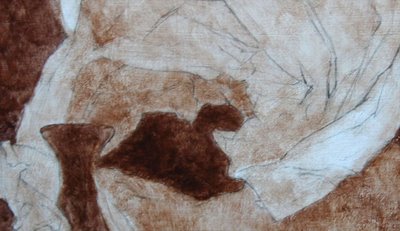
Next I did a rough "closed" underpainting -using white instead of the white of the panel. It got more refined than this but still I consider it an underpainting, thinking only in value and using a very limited palette: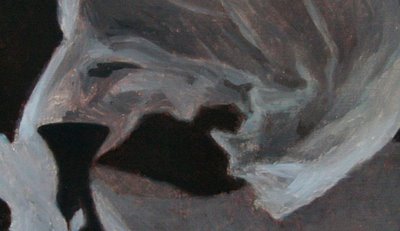
Below is the first stage of the overpainting, where I am using a full spectrum of colors, and no black at all, to get a richer, more colorful range of greys. Here I am making what I think of as a "bed layer" - much more refined than the underpainting, but nowhere near the final level of detail. I'm not trying to paint to a finish, I'm just putting down whatever I think will help me in the final stages.
On to the final layers. At this point I am trying to achieve the highest level of finish possible in a very small area of the painting for every session. At a certain point I can see what I need to do to push the realism further, but I have to wait for the layer to dry before I can do more layers:
Below I am working completely in glazes, using honey-consistency glazing medium with just dark, transparent paints, and occasionally bringing a light area just a bit higher. This looks pretty similar to the previous stage, but it represents many more hours of work. This is the final push for the most impact I am capable of achieving with the paint.
I am also continuing to learn how discerning the human eye is, that a tiny whisper of different value or hue between two adjoining shapes makes a clearly discernible edge. I am constantly experimenting with how subtle a difference I can make that will still read as a difference, and describe form. In the shadowy areas of the wax paper we can see a lot of sculpted form and transparency within a very low value range - dark to black, with just little glimmers for highlights.
It's fun to try to emulate that effect, nudging hues and values around in tiny steps to describe the forms.
 Tuesday, May 12, 2009 at 11:30PM
Tuesday, May 12, 2009 at 11:30PM 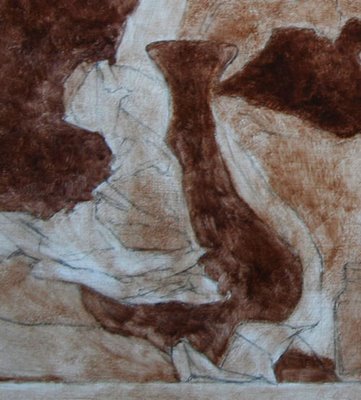

 I'm pretty happy with it at this stage, although for several painting sessions I was really struggling over the brightest areas of wax paper in front. It's always hardest for me to figure out how to paint an area with lots of bright highlights.
I'm pretty happy with it at this stage, although for several painting sessions I was really struggling over the brightest areas of wax paper in front. It's always hardest for me to figure out how to paint an area with lots of bright highlights.
 Sunday, April 12, 2009 at 11:54PM
Sunday, April 12, 2009 at 11:54PM So I've developed my own method. I have found that I need to bring an exciting/challenging area up to the highest finish I can. That sort of sets the standard for the rest of the painting, and I have to bring everything else up to the same standard. It keeps me excited to work every day and makes it all seem like a fun challenge, and less like an impossible acreage to cover with my tiny brush.
I think every painter must have to develop their own way to approach a painting to stay engaged and motivated, and to avoid over thinking, or avoid just giving up out of frustration or intimidation. It's a psychological dilemma to solve every day in the studio.
I'd love to hear how you solve this. Or, if you are not a painter, how you keep yourself energized and excited for any challenging project? Do you do the fun parts first and crank out the boring bits at the end? Or do you save the best for last? Do you tackle the hardest things right away, or warm up with more manageable steps?
 Monday, March 30, 2009 at 9:59PM
Monday, March 30, 2009 at 9:59PM  Monday, March 30, 2009 at 9:02PM
Monday, March 30, 2009 at 9:02PM 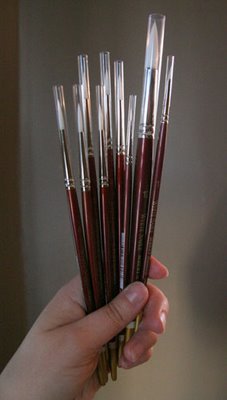
I've been getting some questions about what materials I use, so I thought I'd write a post about it so all my answers are in one place.
Brushes
I love love love Robert Simmons brushes. They are amazingly good quality and amazingly cheap. They are so cheap that when a brush loses it's springiness or it frays, I just toss it and grab a new brush. I use the 785 series white sable round, mostly sizes 4, 1, and 8/0. I also make my own smaller brush with an x-acto knife, by trimming off half the hairs of an 8/0 size brush.
Paints
Use good quality brands. Cheap oil paints are just less pigment and more oil, so you use more anyway. A tube of cheap paint actually feels lighter in the hand than the same color tube of a higher quality paint! I like Sennelier brand. I've never used Old Holland but I've heard those are the best and plan to try them out as I need to replace my tubes. I was taught by Kirstine Reiner to grind my own paints, which is really the best way to paint, and not as difficult as it might seem. I'm starting to be annoyed by the "graniness" of prepackaged paints, so maybe I'll get around to mixing my own again someday.
Palette
I use a small brown wooden handheld palette. I've tried white palettes, glass palettes, and huge oversized wooden handheld palettes, but I always go back to the little brown one. And I often clamp it to the easel just below my painting so I don't have to hold it.
Mediums
I mix my mediums in a clear, straight-edged jar, and I make a few evenly spaced marks up the side with a small sharpie for measuring by "parts".
Underpainting medium (for thin, transparent layers)
2 parts linseed oil
1 part turp
Painting medium (for heavier oil, later layers)
1 part linseed oil
1 part stand oil
Panels
Art Board
Gesso
I mix my own, but it's a big project, so for smaller/faster paintings I use a Art Board brand gesso.
Brush cleaner
Turpenoid Natural in the green can is great for cleaning brushes, I swish my brushes in it to clean them in a "Silicoil" jar. I like that it leaves the bristles pliable and conditioned and never dries them. I don't use Turpenoid Natural in my paints or mediums though, it seems to dry sticky and I'd be afraid of what that would do to a finished painting over time.
 Thursday, March 26, 2009 at 8:31PM
Thursday, March 26, 2009 at 8:31PM Here are the stages:
 Overpainting stage 2
Overpainting stage 2 Overpainting stage 3
Overpainting stage 3This painting and all others listed under "available work" are for sale. Please email me for a price list.
If you haven't yet, come on over and check out my new blog, Women Painting Women, it's a great collection of 59 amazing artists and counting!
 Thursday, March 19, 2009 at 8:18PM
Thursday, March 19, 2009 at 8:18PM A reader asked me recently what I use for the underpainting. My process always evolves, but today I used Mars Red, Ultramarine Blue, and a little touch of Titanium white. I used the palette knife first to mix up a nice batch of this combination, mixing in my underpainting medium (2p linseed, 1p turp) so I had a nice big puddle of paint on my palette with the correct consistency.
I tend to be against pre-mixing and I usually just dip my brush in whatever I need as I paint, and but it felt like a luxury to paint with a generous puddle and saved a lot of time, so I'll probably keep doing it.
A note about materials and process: I am not a precise, materials, craft-obsessed painter. I tend to hate recipes and I get impatient with complicated preparation. However, I am finding a strange thing happening. As I get more refined in my painting I am more sensitive to materials and I am getting more and more interested in craft. I'm not generally drawn to craft for craft's sake but good materials made of simple, high quality ingredients, prepared carefully, make a huge difference for painting.
I think it's possible to get distracted by materials and craft though, so the needs of the painting should drive the investigation of materials. Craftsmanship and materials should save time and make painting more enjoyable, not the reverse.
 Thursday, March 19, 2009 at 8:06PM
Thursday, March 19, 2009 at 8:06PM I'm trying to set up a base layer that will help me when I am working on smaller details in the final stages. I want each large area to already have a defined value range, so I don't make the darks too dark and or the lights too light within a given area.
I'm also avoiding painting the lightest lights or darkest darks at this point because I want to reserve the option to punch a dark back,or pop a light out from this range of midtones.
Once this layer is dry I think I'm ready to move on to the fun part, the actual painting.
 Tuesday, March 17, 2009 at 9:59PM
Tuesday, March 17, 2009 at 9:59PM I'm trying an experiment, so see if I can work on a series of small paintings while I also work on a large painting. My plan is to work most the day on the Big Painting, but reserve an hour or two to work on the smaller project, hopefully one that I can finish in a week.
I'm usually completely focused on one painting at a time, which I like because I go to bed thinking about it and wake up knowing what I'm going to start in the studio instead of dithering about What To Do. But at my current rate of output it will take me forever to get to my goal of 30 portfolio-standard pieces. So I'm hoping I can speed up and start cranking out more than one painting every month or two.
On another note, I've started a new blog devoted to contemporary Women Painting Women. If you have any suggestions for work to include there please email me! sadiej[at]gmail.com
 Wednesday, March 4, 2009 at 7:20PM
Wednesday, March 4, 2009 at 7:20PM  Friday, February 27, 2009 at 7:26PM
Friday, February 27, 2009 at 7:26PM 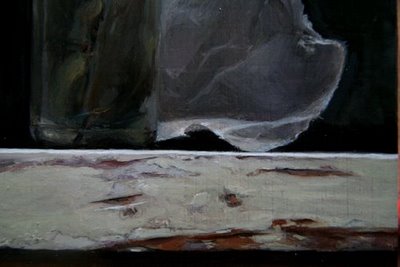
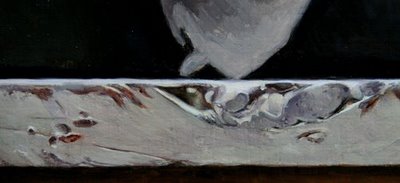 Had fun spending most the day on the front edge of the shelf, all the chipped paint and knots and scratches were so satisfying to paint, and so much faster than the wax paper. Now everything is done except for a couple more sessions on the wax paper.
Had fun spending most the day on the front edge of the shelf, all the chipped paint and knots and scratches were so satisfying to paint, and so much faster than the wax paper. Now everything is done except for a couple more sessions on the wax paper.
See the previous post about this painting here
 Wednesday, February 25, 2009 at 9:11PM
Wednesday, February 25, 2009 at 9:11PM My goal is to capture that "vibration" feeling, that makes the viewer feel like they are really seeing my subject (meaning *I* have truly seen and recorded my subject). Not quite there yet.
I'm finding working smaller is not at all faster than working large - people lean in closer to a small painting, so I think the "vibration" feeling will require an even higher level of finish.
As usual, I'm not painting up to the lightest lights yet, I've found it works best to nearly finish the whole thing and go in at the very end with pure white highlights.
As I think most painters will relate, there is always the temptation to pop in the highlights early on. But I find it skews my perception of the value range, and I end up shifting everything too light if I don't intentionally stay a few steps darker than the highlights for most the painting process.
Have you ever had that feeling that you wish there was a brighter tube of paint than white? When you are sure there is only pure, uncontaminated white paint on your brush, but it doesn't look like a highlight when you put it on the canvas? You wash your brush thoroughly and try again, and it's still doesn't "pop"? I hate that, it's the sign of a painting that has lost its value range. May as well wipe down and start over!
Anyway, I'm hoping to finish this one soon, there's a nice row of still lifes lined up on my shelf ready to be painted...
Previous post about this painting is here
UPDATE: I got a question about what my painting medium is, here are the recipes I use:
Underpainting:
2 parts refined linseed oil
1 part rectified turpentine
Overpainting:
1 part refined linseed oil
1 part stand oil